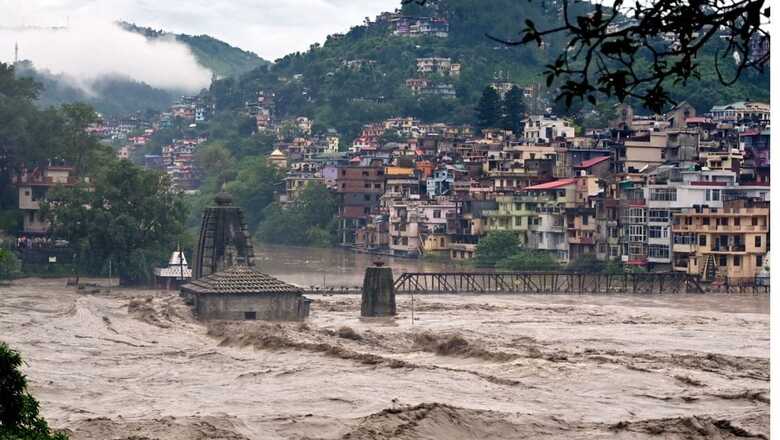
views
If we want to save the country from the Himalayan disaster, prevent desertification of the Ganga valley and progress, the only remedy is to thaw all road, infra and construction activities for some time. Devastating floods, landslides, mudslides in Himachal, Uttarakhand and drowning of large tracts in Delhi because of dam overflows for the first time in 45 years is unprecedented but experts say these are natural outcomes of three factors — climate crisis, a young mountain range and unplanned infrastructure projects.
This year’s devastation has been precipitated by intense constructions like road widening, dam construction and other poorly planned activities, which weakened the hill slopes and triggered major landslides. Crucial road links between Kalka and Shimla, Kullu and Manali, Chandigarh and Manali, Manali and Leh, and Dehradun and Haridwar have been disrupted as roads caved in or landslides occurred. A total of 170 routes had to be closed in Uttarakhand alone.
In both Himachal and Uttarakhand, it is visible that the blasting of the hills has changed the hydro flow pattern that winded through the forests and myriad hilly tracks. The rainwater earlier used to replenish the aquifers and would flow through hundreds of natural paths. Having now destroyed this naturality, it flows straight down the pucca, often concretised roads, which turn into massive artificial drains with logs and boulders rolling down. As the roads were built, trees were felled. Those that could not be sold were dumped under the roads. It dislodged with heavy rain and dangerously flowed through habitats.
Jawaharlal Nehru University (JNU) physicist Dr Vikram Soni, who has closely studied the river systems of North India, told a researcher that he repeatedly emphasised the need to ban construction on the floodplains completely. “The Sutlej and Beas have wreaked so much havoc because indiscriminate construction was allowed on their flood plains. During the monsoon, when the river flow increases, so does its velocity. The situation is worsened with the dumping of debris and other muck from road construction.”
According to the Landslide Atlas of India prepared by the National Remote Sensing Centre, ISRO, all 12 districts of Himachal are susceptible to landslides. These also have the maximum construction activities. Earlier, a different pattern was followed for hill constructions. Now tall concrete constructions are the most susceptible. The landslide exposure analysis carried out in the mountainous areas covering 147 districts in 17 states ranked Mandi district of Himachal at 16th place, followed by Hamirpur 25, Bilaspur 30, Chamba 32, Solan 37, Kinnaur 46, Kullu 57, Shimla 61, Kangra 62, Una 70, Sirmaur 88 and Lahaul and Spiti 126 in socio-economic parameter risk exposure map.
The scale of disasters in the hilly regions has multiplied with the creation of smaller states like Uttarakhand. Checks and balances that a larger Uttar Pradesh ensured have been thrown to the winds. UP was blamed for neglecting the region but nobody talked of how it prevented major disasters. Construction, building and real estate greed has been yet another major setback.
Scientists at the Wadia Institute of Himalayan Geology have repeatedly warned that 51 percent of Uttarakhand has crossed the “very high susceptibility zone”. Therefore, landslides will increase, as will flooding. These scientists have documented Uttarakhand’s 300-plus landslides in 2023. In such a situation, even mitigation measures will not work.
In Uttarakhand, the railway tunnel to Karnaprayag is a disaster. It has not only weakened the hill structure, but also devastated the aquifers that used to feed the various water bodies and natural falls, causing severe water scarcity in the villages. The greed may cause the entire Ganga Valley to turn into a desert.
Everybody can see now how methodical the colonial rulers were. Their ecologically crafted roads exist till today without damaging the Himalayan ecology. A stark replica of that is seen at the India Gate Central Vista. During rains, Delhiites used to throng the Boat Club lawns. It never submerged. But now, even the redone lawns submerge.
Most devastations are along the roads and riverside, which were encroached upon for the convenience of driving vehicles and real estate activity to boost tourism. Nobody can estimate how much is lost. It will be all guesses. The obvious is that the spree of investment since the Himalayan Char Dham roads has literally gone down the rivers. Innumerable bridges and culverts, resorts, townships and vehicles have been washed away. Himalayan warnings are grim and a reality. If not heard, a sub-continental disaster may be an epochal reality.
The writer is a senior journalist. Views expressed in the above piece are personal and solely that of the author. They do not necessarily reflect News18’s views.




















Comments
0 comment